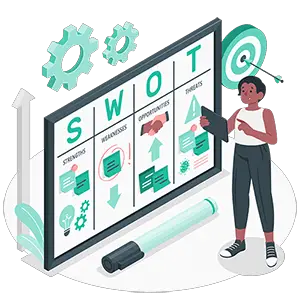Of course! Here’s a set of Frequently Asked Questions (FAQs) related to SWOT analysis:
1. What is a SWOT analysis?
A SWOT analysis is a strategic planning tool that helps businesses identify their Strengths, Weaknesses, Opportunities, and Threats.
2. Why is SWOT analysis important?
SWOT analysis provides a clear and structured overview of an organization’s internal capabilities and external environment, enabling informed decision-making and strategic planning.
3. How often should a SWOT analysis be conducted?
While there’s no fixed rule, it’s a good practice to conduct a SWOT analysis annually or when significant changes occur in the business environment or organizational structure.
4. Who should participate in a SWOT analysis session?
Diverse participation, including members from various departments and levels within the company, ensures a comprehensive view. Including external stakeholders like partners or customers can provide additional insights.








